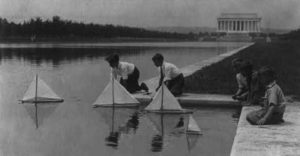This piece was originally published by the National Mall Coalition.
The National Mall is our nation’s premier public space. It is the stage for American democracy, a destination for exploring the country’s history, a place for entertainment, inspiration, and recreation. We inaugurate presidents here. We commemorate important events and people. We reflect on war and loss. We celebrate the founding ideals of liberty, freedom and democracy. Each year, more than 25 million Americans and tourists from abroad visit the Mall to take in its inspiring memorials, museums, and other attractions. Local residents, too, make great use of the open space for organized sports. Ultimately, it is “we the people” and how we use the Mall that makes it such an important public space in American civic life.
Over the last few years, as I researched my new book, The National Mall: No Ordinary Public Space, I came to appreciate how crucial public use of this open space is to the health of our democracy. And yet, there are troubling signs that public use and access are eroding, slowly and quietly.
Recent developments appear to restrict access and use of the Mall. For one, the Park Service encouraged (or maybe forced, it’s unclear) the annual book festival off the Mall in 2013. The Library of Congress spent months trying to work with the Park Service to keep the festival on the Mall, but was not successful. Although the festival is held now at the DC Convention Center, one enthusiast lamented the fair seemed to lose its “soul” in this new location.
A similar push off the Mall may be in store for the popular summer Smithsonian Folk Life Festival. In the last several years, the Festival has been scaled back from its previous size. The reason: new regulations by the Park Service now restrict large events because they trample the grass. Ironically, The Secretary of the Interior, Ken Salazar said these restrictions would help ensure the Mall would be able to accommodate the millions of visitors in years to come.

Another visible sign of “turf wars” has been the temporary fencing off of areas to protect the sod. But will these really be temporary use restrictions? There’s also a rumor that local recreation groups that have been permitted to play volleyball, softball, and other sports on the Mall for decades may also have to find new venues. Securing permits for these important recreational opportunities is more and more difficult. Examples like these show public use and access to the Mall are under threat.
We’re concerned. Why are some of the most popular Mall activities having to look elsewhere for a home? What is happening to the idea of “public” in this public space? One wonders under the thinking prevalent today whether the historic 1963 March on Washington and Martin Luther King’s memorable speech on the steps of the Lincoln Memorial might have been directed to find another location.
A guiding mission of the Park Service is preservation of the resources for future generations. Keeping the turf in good shape is an important maintenance issue, but it shouldn’t come at the expense of public access and use. The Mall, unlike other park units, is a constantly evolving space. And because it is our stage for democracy, access to and use of the Mall for all of the various purposes must remain equally as important as preservation.
In the end, if public use of the Mall is to receive the priority it should, then the public needs to voice its support for access, for more than just healthy turf as important as that may be. If people and events are being pushed off the Mall, we will soon lose the “public” in public space. Lets’ talk about this before it’s too late.
~ Lisa Benton-Short is an Associate Professor of Geography at George Washington University and a Senior Fellow at the GW Sustainability Collaborative. Her new book, The National Mall: No Ordinary Public Space, is published by University of Toronto Press. Gordon Binder is a Senior Fellow at World Wildlife Fund.


